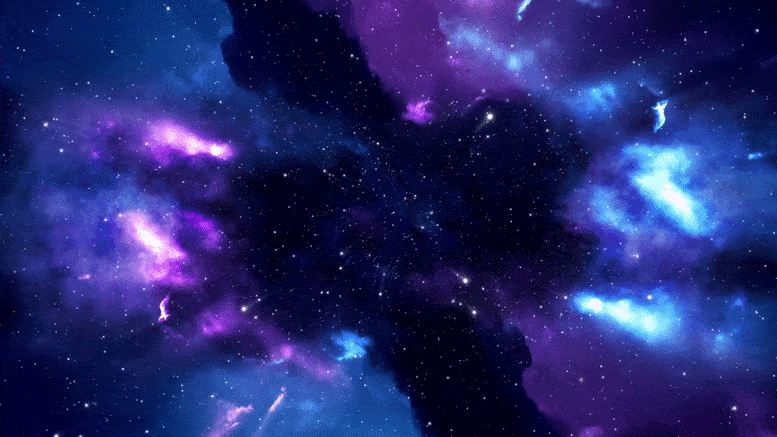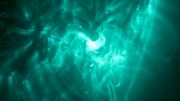
Researchers have generated a detailed map of the galactic wind driving exchanges between a young galaxy in formation and a nebula.
- Galaxies exchange matter with their external environment thanks to galactic winds.
- The MUSE instrument from the Very Large Telescope has, for the very first time, mapped the galactic wind that drive these exchanges between galaxies and nebulae.
- This observation led to the detection of some of the Universe’s missing matter.
Galaxies can receive and exchange matter with their external environment thanks to the galactic winds created by stellar explosions. Thanks to the MUSE instrument[1] from the Very Large Telescope at the ESO, an international research team, led on the French side by the CNRS and l’Université Claude Bernard Lyon,[1,2] has mapped a galactic wind for the first time. This unique observation, which is detailed in a study published in MNRAS on September 16, 2021, helped to reveal where some of the Universe’s missing matter is located and to observe the formation of a nebula around a galaxy.
Galaxies are like islands of stars in the Universe, and possess ordinary or baryonic matter, which consists of elements from the periodic table, as well as dark matter, whose composition remains unknown. One of the major problems in understanding the formation of galaxies is that approximately 80% of the baryons[3] that make up the normal matter of galaxies is missing. According to models, they were expelled from galaxies into intergalactic space by the galactic winds created by stellar explosions.

Observation of a part of the Universe thanks to MUSE Left: Demarcation of the quasar and the galaxy studied here, Gal1. Center: Nebula consisting of magnesium represented with a size scale Right: superimposition of the nebula and the Gal1 galaxy. Credit: © Johannes Zabl
An international team,[4] led on the French side by researchers from the CNRS and l’Université Claude Bernard Lyon 1, successfully used the MUSE instrument to generate a detailed map of the galactic wind driving exchanges between a young galaxy in formation and a nebula (a cloud of gas and interstellar dust).
The team chose to observe galaxy Gal1 due to the proximity of a quasar, which served as a “lighthouse” for the scientists by guiding them toward the area of study. They also planned to observe a nebula around this galaxy, although the success of this observation was initially uncertain, as the nebula’s luminosity was unknown.
The perfect positioning of the galaxy and the quasar, as well as the discovery of gas exchange due to galactic winds, made it possible to draw up a unique map. This enabled the first observation of a nebula in formation that is simultaneously emitting and absorbing magnesium—some of the Universe’s missing baryons—with the Gal1 galaxy.
This type of normal matter nebula is known in the near Universe, but their existence for young galaxies in formation had only been supposed.
Scientists thus discovered some of the Universe’s missing baryons, thereby confirming that 80–90% of normal matter is located outside of galaxies, an observation that will help expand models for the evolution of galaxies.
Notes
- MUSE, which stands for Multi Unit Spectroscopic Explorer, is a 3D spectrograph designed to explore the distant Universe. The Centre de recherché astrophysique de Lyon (CNRS/Université Claude Bernard-Lyon 1/ENS de Lyon) led its construction.
- Researchers from the Centre de recherché astrophysique de Lyon (CNRS/Université Claude Bernard Lyon 1/ENS de Lyon), the Galaxies, étoiles, physique, instrumentation laboratory (CNRS/Observatoire de Paris – PSL), and the Institut de recherché en astrophysique et planétologie (CNRS/Université Toulouse III – Paul Sabatier/CNES) participated in the project.
- Baryons are particles consisting of three quarks, such as protons and neutrons. They make up atoms and molecules as well as all visible structures in the observable Universe (stars, galaxies, galaxy clusters, etc.). The “missing” baryons, which had never before been observed, must be distinguished from dark matter, which consists of non-baryonic matter of an unknown nature.
- Including scientists from Saint Mary’s University in Canada, the Institute for Astrophysics at the University of Potsdam in Germany, Leiden University in the Netherlands, the University of Geneva and the Swiss Federal Polytechnic School in Zurich, the Inter-University Centre for Astronomy and Astrophysics in India, and the University of Porto in Portugal.
Reference: “MusE GAs FLOw and Wind (MEGAFLOW) VIII. Discovery of a Mgii emission halo probed by a quasar sightline” by Johannes Zabl, Nicolas F Bouché, Lutz Wisotzki, Joop Schaye, Floriane Leclercq, Thibault Garel, Martin Wendt, Ilane Schroetter, Sowgat Muzahid, Sebastiano Cantalupo, Thierry Contini, Roland Bacon, Jarle Brinchmann and Johan Richard, 28 July 2021, Monthly Notices of the Royal Astronomical Society.
DOI: 10.1093/mnras/stab2165









The MIA matter was perhaps first observed here a year ago:
“An international team of astronomers has solved the decades-old mystery of the ‘missing matter’ long predicted to exist in the universe but never before detected. The researchers have now found all of the missing ‘normal’ matter in the vast space between galaxies.
The discovery, published May 27 in Nature, was made by studying massive flashes of energy from deep space, called fast radio bursts.”
The newer observations put more detail on the intergalactic gas flows.
https://news.ucsc.edu/2020/05/missing-matter.html
Question: In the Creators Unnerve, IS the Mater used in the creation of Life, that could be called “Living Mater”. The binding of physical mater and Bio-energy which is a product of creation, Can also be called Dark Mater??
Thanks to the large Telescop to catch this special galaxy in the universe having winds and nebula. It is done never before. Scientists will get new discoveries of universe now.
Thanks for a new galaxy having winds.
@S.Michael it’s like tow mater without the tow! I didn’t know an animated tow truck could break the 4th wall and become an astrological discovery. So the producers of Cars were way ahead of their time huh?